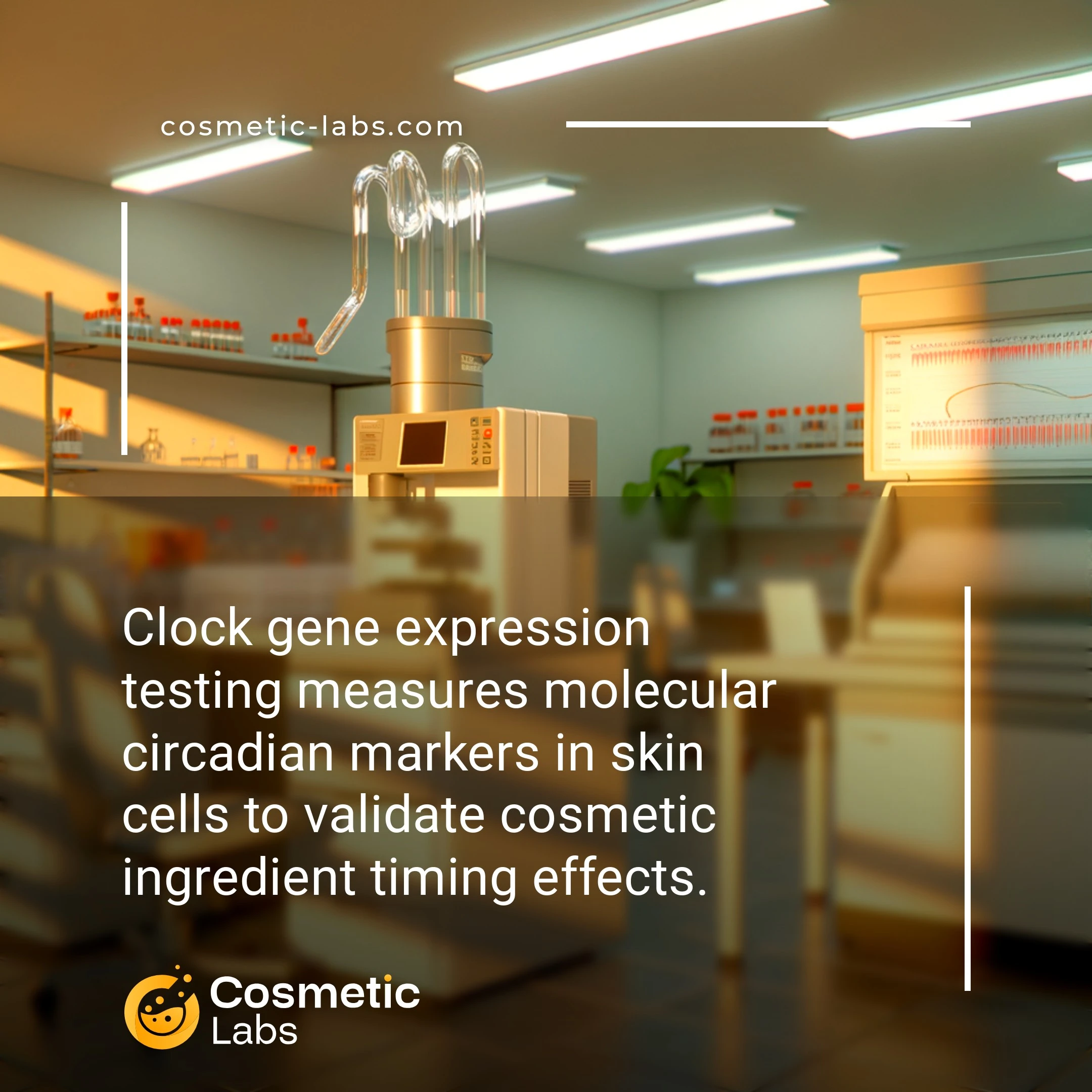Clock Gene Expression Testing for Circadian Beauty Products

What is Clock genes expression?
Clock gene expression testing for circadian rhythm efficacy measures how cosmetic ingredients influence cellular timekeeping mechanisms in skin cells. Labs analyze specific genes like CLOCK, BMAL1, and PER2 to determine whether your anti-aging or sleep-promoting formulations actually synchronize skin’s natural repair cycles. This molecular-level assessment reveals whether ingredients like melatonin or chronopeptides trigger the desired circadian responses, giving you scientific proof for marketing claims about overnight skin renewal.
Why do you need this service?
Beauty brands leverage clock gene expression analysis to validate time-sensitive skincare formulations that sync with natural skin renewal cycles. Labs measure CLOCK, BMAL1, and PER gene activity in keratinocytes after ingredient exposure, providing concrete data on whether your anti-aging serum actually optimizes cellular repair during nighttime hours or if your morning brightening formula enhances daytime protective mechanisms.
Who provides Clock genes expression services?
All cosmetic labs providing Clock genes expression services
There is no company providing these services at the moment.
Clock Gene Expression Testing for Circadian Rhythm Cosmetic Efficacy
Clock gene expression analysis measures how cosmetic ingredients influence cellular circadian rhythms at the molecular level. This testing evaluates whether your beauty products can synchronize skin’s natural 24-hour cycles through targeted gene regulation.
Molecular Circadian Rhythm Assessment
Clock gene expression testing tracks key regulatory genes like CLOCK, BMAL1, and PER1-3 in skin cells. Labs expose cultured keratinocytes or fibroblasts to your formulations, then measure gene activity patterns over 48-72 hour cycles using RT-PCR or RNA sequencing.
The process includes:
- Baseline gene expression profiling in untreated cells
- Treatment application at specific circadian phases
- Time-course sampling every 4-6 hours
- Quantitative analysis of oscillation amplitude and phase shifts
Results show whether your ingredients can restore disrupted circadian patterns or enhance natural rhythm strength.
Circadian Biomarker Validation
Labs measure downstream effects of clock gene modulation on skin function markers. This includes testing melatonin production, cortisol response, and DNA repair gene activation that follow circadian patterns.
Key validation metrics include:
- Oscillation period length (should align with 24-hour cycles)
- Peak expression timing for repair vs. protection genes
- Synchronization between different cell types
- Dose-response relationships for active ingredients
This data supports marketing claims about chronobiology benefits and helps optimize ingredient concentrations for maximum circadian impact. Connect with specialized labs on our platform to validate your circadian rhythm cosmetic concepts.
Practical Applications of Clock Gene Expression Testing for Circadian Rhythm Efficacy
Beauty brands use clock gene expression testing for circadian rhythm efficacy to validate product claims about skin’s natural repair cycles and optimize ingredient timing for maximum effectiveness.
Anti-Aging Product Development
Labs analyze how cosmetic formulations influence CLOCK, BMAL1, and PER gene expression in skin cells during 24-hour cycles. This testing reveals whether ingredients like retinol, peptides, or botanical extracts synchronize with natural cellular repair processes. Product developers receive data showing peak activity windows for specific ingredients, enabling them to create targeted day and night formulations.
Testing protocols measure gene expression changes at 4-hour intervals across circadian cycles. Results help brands substantiate claims about nighttime repair acceleration or daytime protection enhancement with quantifiable molecular evidence.
Chronocosmetic Formulation Validation
Cosmetic labs evaluate how active ingredients affect circadian clock proteins in keratinocytes and fibroblasts. This testing determines optimal concentration ranges and delivery methods for chronobiological skincare products. Brands developing morning energizing serums or evening recovery treatments rely on this data to prove their products work with skin’s natural rhythms.
Gene expression profiling identifies which formulation components enhance or disrupt circadian synchronization. Labs provide detailed reports showing temporal gene activity patterns that support regulatory submissions and marketing claims about circadian-optimized skincare.
| Testing Parameter | Measurement Method | Typical Timeline | Key Output |
|---|---|---|---|
| CLOCK Gene Expression | qRT-PCR Analysis | 48-72 hours | Fold change data |
| BMAL1 Protein Levels | Western Blot | 24-48 hours | Protein quantification |
| PER1/PER2 Oscillation | Luciferase Reporter | 5-7 days | Rhythm amplitude |
| Circadian Phase Shift | Gene Expression Profiling | 72 hours | Phase response curves |
Connect with specialized cosmetic testing labs on our platform to access clock gene expression analysis for your circadian rhythm product development needs.
